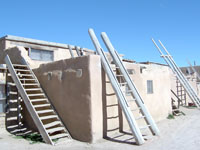
Closed Captioned
Study Guide
Grades 7-12, College, Adult
Directed by Paul M. Rickard
Produced by Tamara Lynch, Paul M. Rickard and Janice Benthin
DVD Purchase $295, Rent $95
, Rent $95
US Release Date: 2006
Copyright Date: 2005
DVD ISBN: 0-7722-1209-0
VHS ISBN: 0-7722-1208-2
Subjects
American Studies
Anthropology
Art/Architecture
Canadian Studies
Community
Design
Environment
Environmental Ethics
Green Building
Humanities
Indigenous Peoples
Native Americans
Science
Technology
Society
Sociology
Technology
Urban Studies
Urban and Regional Planning
Awards and Festivals
Native American Film + Video Festival, National Museum of the American Indian
FIFA, International Festival of Films on Art, Montreal
Denver Indigenous Film Festival
imagineNATIVE Film + Media Arts Festival
Dreamspeakers Film Festival
Living Architecture
New structures in seven North American Native communities that reinterpret traditional forms for contemporary purposes.
 |
"An essential film in many ways...reveals the existence of emerging culturally-specific architectural languages within living Indian communities." Anne Marshall, Dept of Architecture, University of Idaho |
ABORIGINAL ARCHITECTURE, LIVING ARCHITECTURE offers a fascinating in-depth look into the diversity of North American Native architecture. Featuring expert commentary and stunning imagery, this program provides a virtual tour of seven Aboriginal communities -- Pueblo, Mohawk, Inuit, Crow, Navajo, Coast Salish and Haida -- revealing how each is actively reinterpreting and adapting traditional forms for contemporary purposes.
Everyone is familiar with certain types of Aboriginal architecture. Traditional igloos and teepees are two of the most enduring symbols of North America itself. But how much do we really know about the types of structures Native Peoples designed, engineered, and built?
For more than three hundred years, Native communities in North America have had virtually no indigenous architecture. Communities have made do with low-cost government housing and community projects designed by strangers in far away places.
Thankfully, across the continent, political, financial, and cultural changes have created a renaissance of Native design. Modern Aboriginal architects are turning to ancient forms, adapting them in response to changes in the natural and social environment, and creating contemporary structures that hearken to the past.
Employing old and new materials and techniques and with an emphasis on harmony and balance, Native designers are successfully melding current community needs with tradition. The resulting buildings are testaments to the enduring strength and ingenuity of Aboriginal design.
Reviews
"Aboriginal Architecture is enlightening, innovative, informative; It has great educational significance in connecting traditional Native values with contemporary lifeways. It is so exciting to show the impact of Native contributions to the rest of the world; that we are 'more than bows and arrows'. The film definitely has a role in our educational programming at our museum."
"An essential film in many ways. Aboriginal Architecture: Living Architecture links recent Indian architecture in North America to its roots in the past, and in doing so reveals the existence of emerging culturally-specific architectural languages within living Indian communities.
Although the recent construction of the National Museum of the American Indian in Washington, DC, has raised awareness of contemporary Indian identity and the expression of Indian values through architectural design, it does not (and cannot) address tribally-specific architecture because a single building is charged with representing all aboriginal peoples within the Americas. In contrast, Aboriginal Architecture focuses on the architecture of seven tribal groups in North America: the Acoma, Mohawk, Inuit, Crow, Navajo, Coast Salish, and Haida.
One strength of Aboriginal Architecture is the inclusion of voices of Indian people who shape architecture within their communities. Architect Daniel Glenn, who designed the Seven Stars Learning Center at Little Bighorn College, states that 'I would be proud to call myself a Native American architect. I think though, that one of the things I've really focused on is not Native American architecture, but really a tribal architecture.' Glenn then goes on to discuss the challenges of designing contemporary buildings that embody Crow culture when the traditional Crow structure is the portable tipi.
Architecture designed by or for North American Indian people is underrepresented in architectural literature and film. Through the voices and architecture of seven tribal communities in North America, Aboriginal Architecture: Living Architecture begins to fill this gap."
"[Aboriginal Architecture] is very effective in demonstrating how cultural traditions can be expressed in modern architecture. The technical quality of the film is superb...This film would be a very useful addition to collections supporting coursework in Native American Studies or the architecture of indigenous peoples. It would also be suitable for younger audiences studying Native American cultures. Highly Recommended."
"This documentary...is an extraordinary testament to the architectural talents of aboriginal people from across the Americas. In vivid, often breathtaking footage, the film takes an in-depth look at the varied and ingenious ways in which indigenous builders adapted their structures to the cultural needs of their daily lives and to the landscape around the...I recommend it highly."
"This fascinating video would be ideal for students in many different settings...This thoroughly researched, extremely original film should not be missed. If you are studying native history, art and culture, aboriginal homes, building and design, anthropology, archeology, or architecture, it has much to share. Highly Recommended."
"Portrays native design concepts not as a dead, abandoned art form, but as a living, breathing source of inspiration and practicality for architecture in the present day...A wonderfully enriching documentary. Aboriginal Architecture: Living Architecture is especially recommended for classroom viewing by students in grades seven to twelve as well as adult, particularly those engaged in architectural or Native American studies."